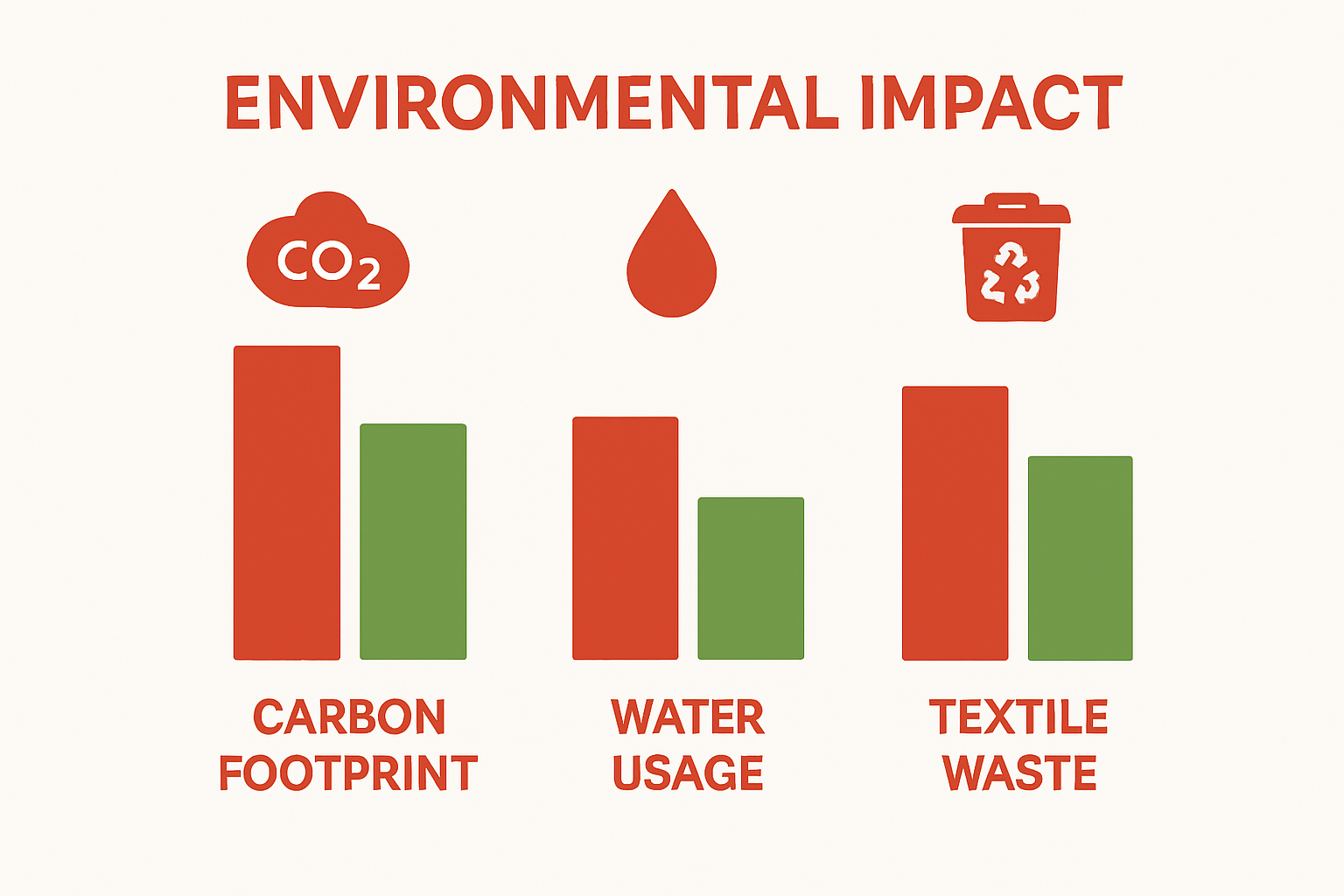
Understanding Sustainable Fashion Practices: A Deep Dive
Share
Sustainable fashion is no longer just a buzzword in the world of clothing. Fast fashion is responsible for a shocking amount of damage, with textile manufacturing generating around 10 percent of all global carbon emissions and using thousands of litres of water for a single shirt. Some people think buying eco-friendly clothes is all about making small sacrifices. Actually, the greatest shift is how these new practices are transforming the entire fashion industry from its roots to the final product, opening doors to smarter design and real social change.
Table of Contents
- What Are Sustainable Fashion Practices?
- Why Sustainable Fashion Matters: The Impact On Environment And Society
- Key Principles Of Sustainable Fashion Practices
- How Sustainable Fashion Works: Processes And Techniques
- Real-World Applications: Brands And Innovations In Sustainable Fashion
Quick Summary
| Takeaway | Explanation |
|---|---|
| Sustainable fashion minimises environmental impact | It focuses on using eco-friendly materials and reducing waste throughout the clothing lifecycle. |
| Fair wages and safe working conditions are essential | Ethical production ensures textile workers are compensated fairly and work in safe environments. |
| Circular design enhances garment longevity | Creating items that can be easily repaired, reused, or recycled supports sustainability. |
| Innovative brands drive sustainable practices | Companies are integrating sustainability into their core business strategies, proving environmental responsibility can be profitable. |
| Consumers play a crucial role in sustainability | Choosing sustainable fashion supports ethical practices and promotes environmental consciousness in the industry. |
What are Sustainable Fashion Practices?
Sustainable fashion practices represent a holistic approach to clothing production and consumption that prioritises environmental protection, social responsibility, and ethical manufacturing processes. These practices aim to minimise the fashion industry’s negative impact on our planet while creating high-quality, long-lasting garments that respect both human resources and ecological systems.
Environmental Considerations in Fashion
At the core of sustainable fashion practices are environmental strategies designed to reduce waste, conserve resources, and minimise carbon footprints. According to research from the Sustainability journal, these practices encompass several critical elements:
- Selecting eco-friendly materials like organic cotton, recycled polyester, and regenerated textiles
- Implementing water-efficient manufacturing processes
- Reducing chemical usage in textile production
- Designing products with circular economy principles in mind
These approaches transform traditional fashion manufacturing from a linear model of production and disposal to a more responsible, regenerative system that considers long-term environmental consequences.
Social and Ethical Dimensions
Sustainable fashion practices extend beyond environmental concerns to include crucial social considerations. This means ensuring fair wages, safe working conditions, and respecting worker rights throughout the global supply chain. By prioritising transparency and ethical labour standards, brands can create meaningful change in an industry historically marked by exploitation.
Key social principles include:
- Guaranteeing living wages for textile workers
- Providing safe, regulated working environments
- Supporting local artisan communities
- Promoting gender equality in manufacturing sectors
Ultimately, sustainable fashion practices represent a comprehensive reimagining of how clothing is conceived, produced, consumed, and ultimately recycled or returned to natural systems. By embracing these principles, fashion can become a powerful tool for positive global transformation.
Why Sustainable Fashion Matters: The Impact on Environment and Society
Sustainable fashion transcends aesthetic choices and represents a critical global response to environmental degradation and social inequality. By challenging the traditional linear model of fashion production, this approach addresses some of the most pressing challenges facing our planet and its inhabitants.
Environmental Consequences of Traditional Fashion
The fashion industry stands as one of the most environmentally destructive sectors globally. Research from Columbia University reveals the staggering environmental impact of conventional clothing production:
- Textile manufacturing generates approximately 10% of global carbon emissions
- The industry consumes massive quantities of water, with a single cotton shirt requiring up to 2,700 litres
- Synthetic fabrics release microplastics into water systems during washing
- Landfills receive millions of tonnes of textile waste annually
These statistics underscore the urgent need for systemic transformation in how we conceive, produce, and consume clothing.
To clarify the environmental impact of conventional fashion versus the goals of sustainable fashion, the following table summarises key points for easy comparison.
| Aspect | Traditional Fashion | Sustainable Fashion |
|---|---|---|
| Carbon Emissions | Approximately 10% of global emissions | Aims to minimise carbon footprint |
| Water Use | High (e.g., 2,700 litres per shirt) | Employs water-efficient processes |
| Material Source | Conventional, synthetic, or non-renewable | Eco-friendly and renewable materials |
| Waste Generation | Millions of tonnes annually | Focus on circular design, waste reduction |
| Chemical Usage | High (many hazardous chemicals) | Reduced or safer chemical use |
| Lifecycle | Linear: produce, use, dispose | Circular: repair, reuse, recycle |

Social Justice and Human Rights
Sustainable fashion is fundamentally about human dignity. Traditional fashion supply chains have long been associated with exploitative labour practices, particularly in developing countries. By prioritising ethical production, sustainable fashion seeks to create fair working conditions, living wages, and safe environments for textile workers.
Key social impact considerations include:
- Eliminating child labour in textile manufacturing
- Ensuring safe workplace conditions
- Providing fair compensation for artisans and workers
- Supporting local and indigenous textile communities
By choosing sustainable fashion, consumers become active participants in a global movement towards more equitable and responsible production systems. This approach recognises that true sustainability encompasses both environmental stewardship and social justice.
Key Principles of Sustainable Fashion Practices
Sustainable fashion represents a comprehensive approach to clothing design, production, and consumption that prioritises environmental stewardship, social responsibility, and long-term economic viability. These practices are guided by fundamental principles that challenge traditional fashion industry paradigms and promote a more holistic, ethical approach to clothing.
Circular Design and Material Selection
According to the European Environment Agency, circular design serves as a cornerstone of sustainable fashion practices. This principle involves creating garments with their entire lifecycle in mind, from initial conception to eventual recycling or biodegradation.
Key elements of circular design include:
- Selecting materials that can be easily recycled or naturally decompose
- Designing products with modular components for easier repair
- Creating versatile garments that can be repurposed or transformed
- Minimising waste during the production process
By embracing circular design, fashion brands can significantly reduce their environmental footprint and create more resilient, adaptable clothing systems.

Ethical Production and Transparency
Sustainable fashion demands a radical reimagining of manufacturing processes, centring human dignity and environmental protection. This means establishing transparent supply chains that prioritise worker welfare, fair compensation, and safe working conditions.
Critical ethical production principles include:
- Ensuring living wages for all workers in the supply chain
- Providing safe, regulated working environments
- Supporting local and indigenous textile communities
- Maintaining complete transparency about manufacturing processes
These principles transform fashion from a purely commercial endeavour into a vehicle for social and environmental change, recognising that true sustainability encompasses both ecological and human considerations.
To assist readers, this table outlines the core principles of sustainable fashion practices along with concise explanations of each principle.
| Principle | Explanation |
|---|---|
| Circular Design | Creating garments with repair, reuse, and recycling in mind throughout lifecycle |
| Ethical Production | Ensuring fair wages, safe conditions, and labour rights |
| Transparency | Maintaining open information on sourcing and production methods |
| Eco-friendly Materials | Using renewable, recycled, or biodegradable textiles |
| Waste Reduction | Minimising waste at all stages of production and design |
| Social Responsibility | Supporting local artisans and promoting gender equality |
How Sustainable Fashion Works: Processes and Techniques
Sustainable fashion operates through innovative processes that reimagine traditional clothing production, transforming each stage of manufacturing to minimise environmental impact and maximise social responsibility. This approach integrates cutting-edge technologies, advanced materials, and holistic design strategies to create garments that are both environmentally conscious and aesthetically compelling.
Material Innovation and Sourcing
According to research from Wageningen University, sustainable fashion begins with radical material selection and sourcing strategies. These techniques focus on identifying and developing textiles that reduce ecological footprints while maintaining high-quality performance.
Key material innovation approaches include:
- Using regenerated fibres from recycled plastic bottles
- Developing bio-based textiles from agricultural waste
- Implementing organic farming practices for natural fibres
- Creating fabrics from innovative sources like algae and mushroom mycelium
These methods challenge conventional textile production by introducing materials that are renewable, biodegradable, and significantly less resource-intensive.
Upcycling and Waste Reduction
Upcycling represents a transformative technique in sustainable fashion, converting potential textile waste into valuable new products. By reimagining fabric remnants and discarded materials, designers can create unique garments while dramatically reducing environmental waste.
Critical upcycling strategies encompass:
- Repurposing fabric offcuts into new clothing designs
- Transforming industrial textile waste into functional textiles
- Creating multi-functional garments with adaptable design elements
- Developing closed-loop production systems that minimise material loss
Through these innovative approaches, sustainable fashion demonstrates that ecological responsibility and creative design can coexist harmoniously, offering consumers environmentally conscious alternatives to traditional clothing production.
Real-World Applications: Brands and Innovations in Sustainable Fashion
Sustainable fashion has transitioned from a niche concept to a transformative global movement, with innovative brands and technologies demonstrating that environmental responsibility and commercial success can coexist harmoniously. These pioneering approaches are reshaping the fashion industry’s fundamental operational paradigms.
Industrial Scale Innovations
According to the Sustainable Fashion Innovation Society, emerging technologies and business models are revolutionising how clothing is conceived, produced, and consumed. Industrial-scale innovations are proving that sustainability can be both economically viable and technologically sophisticated.
Key industrial innovation strategies include:
- Developing digital tracking systems for clothing lifecycle management
- Creating plant-based material alternatives to traditional textiles
- Implementing automated recycling technologies
- Designing closed-loop manufacturing processes
These technological interventions represent a significant departure from traditional linear production models, offering more transparent, efficient, and environmentally conscious approaches to fashion manufacturing.
Pioneering Sustainable Brand Strategies
Innovative brands are demonstrating that sustainability can be a core business strategy rather than a peripheral consideration. By integrating ecological principles into their fundamental operations, these companies are challenging industry norms and setting new standards for responsible production.
Notable sustainable brand approaches encompass:
- Implementing comprehensive recycling and upcycling programmes
- Creating garments from regenerated or bio-based materials
- Offering transparent supply chain information to consumers
- Developing circular business models that prioritise product longevity
Through these strategic innovations, sustainable fashion brands are proving that environmental responsibility can drive creativity, consumer engagement, and economic success.
Experience Sustainable Luxury Without Compromise
Are you searching for ways to embrace sustainable fashion in your own life, moving beyond disposable trends and fast fashion? The article explained how the fashion industry’s traditional methods harm the environment and social wellbeing, and highlighted the urgent need for ethically made, long-lasting pieces. Many shoppers want to make better choices but struggle to find luxury accessories that align with these principles.
At San Rocco Italia, we believe luxury and conscientious living go hand in hand. Our handbags and leather goods are meticulously crafted in Italy with premium full-grain leather, using trusted artisan methods that stand the test of time. Each piece exemplifies the article’s circular design and ethical production values, offering authenticity and sustainability in one.

Commit to timeless elegance that honours our planet and its people. Explore our curated collection at San Rocco Italia and choose accessories that reflect your commitment to a better fashion industry. Discover your next investment in sustainable craftsmanship today.
Frequently Asked Questions
What are sustainable fashion practices?
Sustainable fashion practices encompass clothing production and consumption methods that prioritise environmental protection, social responsibility, and ethical manufacturing, aiming to minimise the fashion industry’s negative impact on the planet.
How does the traditional fashion industry affect the environment?
The traditional fashion industry significantly contributes to environmental degradation, generating about 10% of global carbon emissions, consuming vast amounts of water, releasing microplastics into waterways, and producing enormous quantities of textile waste annually.
What principles guide sustainable fashion practices?
Key principles of sustainable fashion include circular design, ethical production, transparency in supply chains, and the use of eco-friendly materials, all aimed at fostering environmental stewardship and social responsibility.
How can consumers contribute to sustainable fashion?
Consumers can contribute to sustainable fashion by choosing eco-friendly materials, supporting brands that prioritise ethical production, opting for upcycled products, and practising mindful consumption, such as buying less and recycling or donating unwanted clothing.


